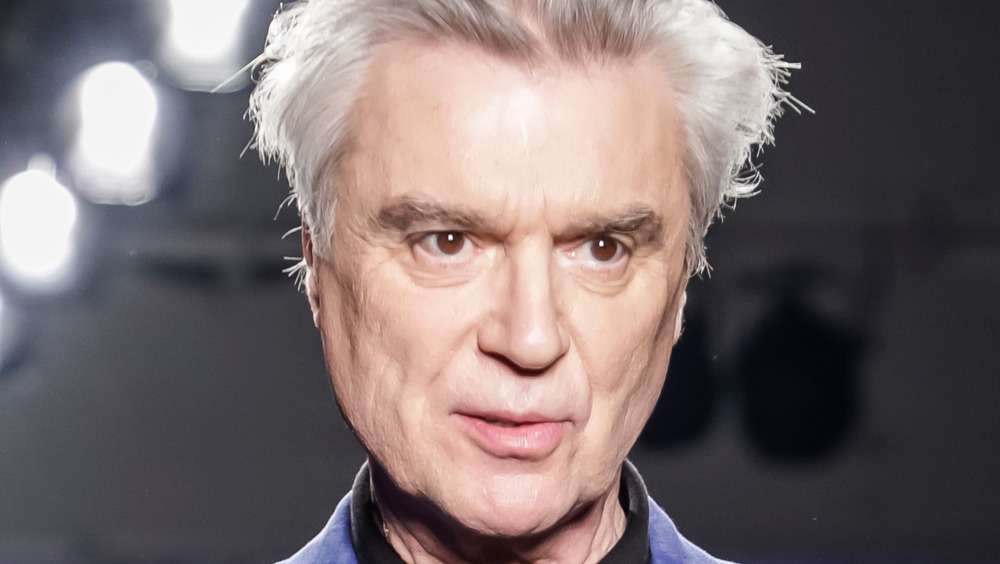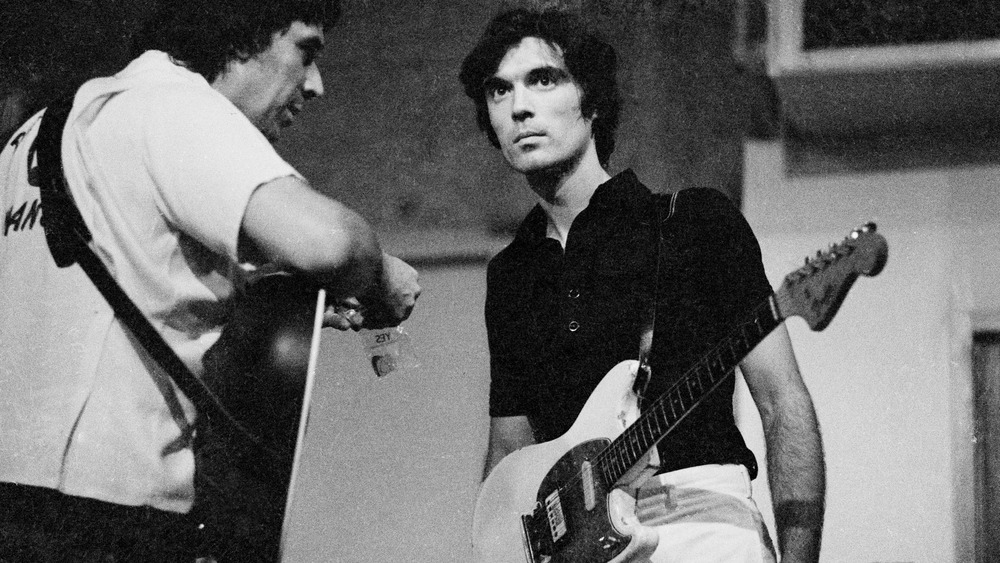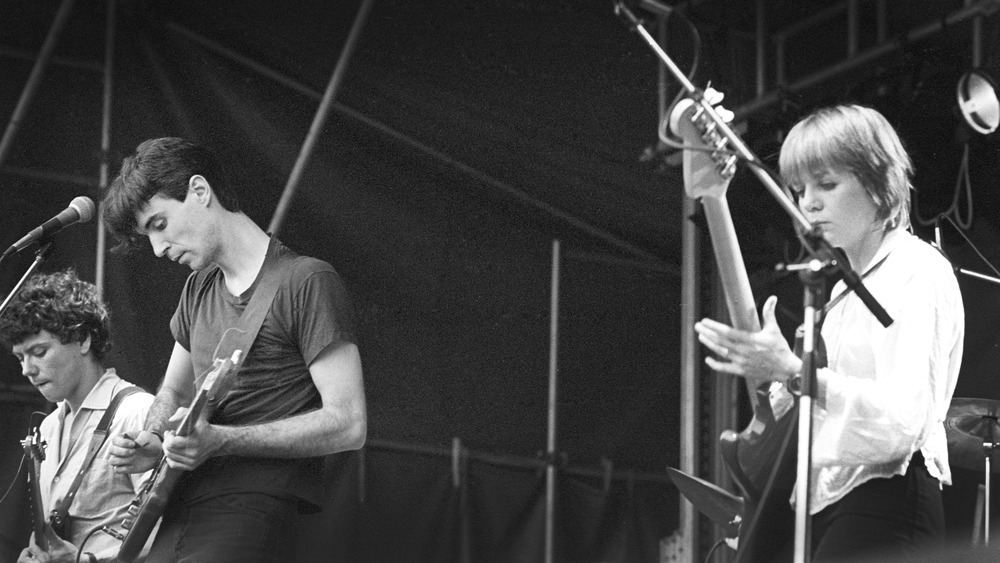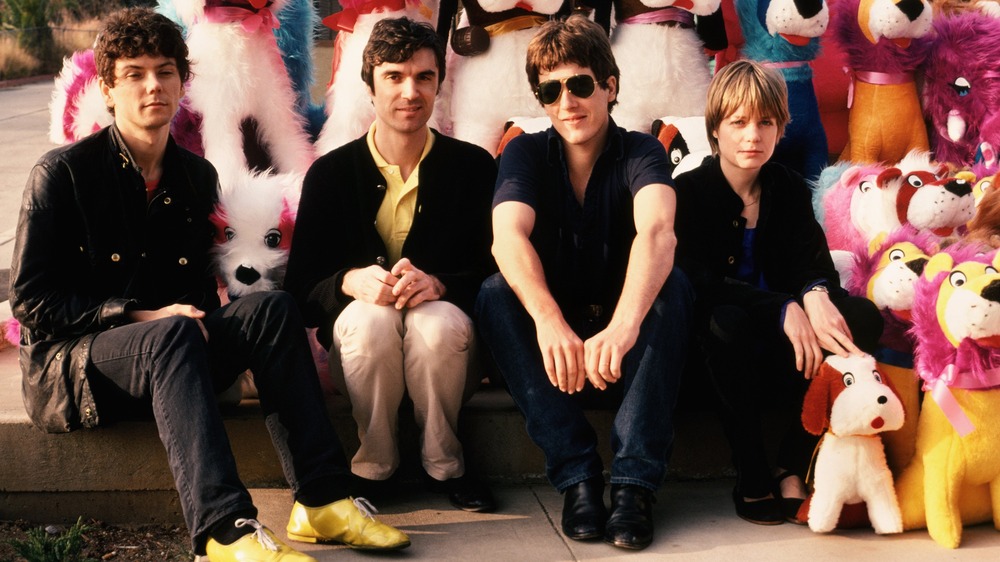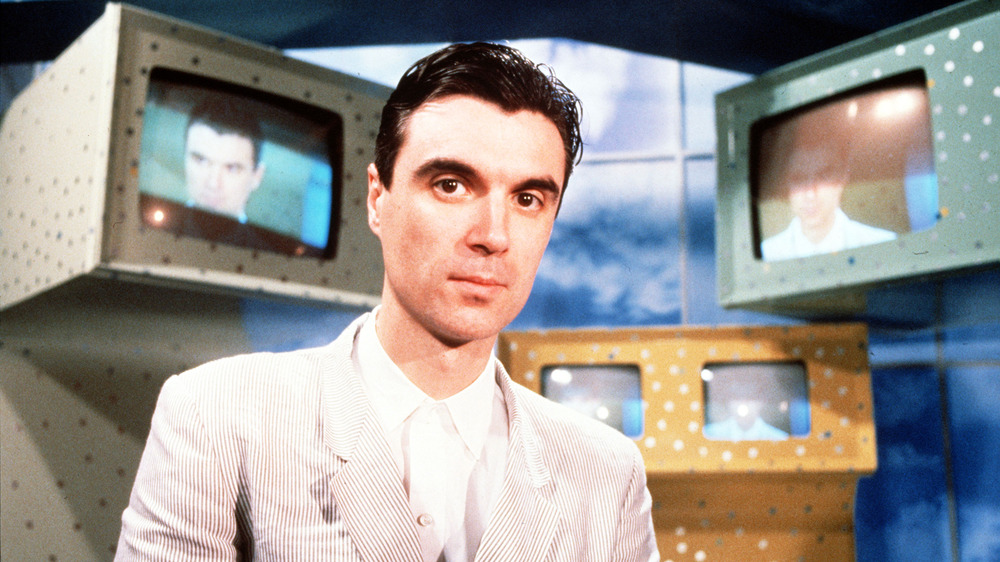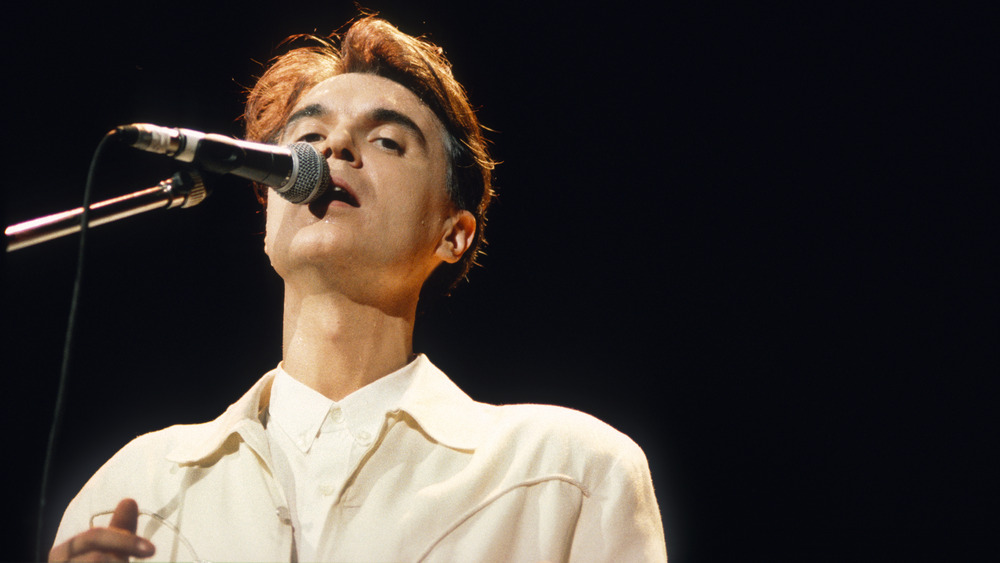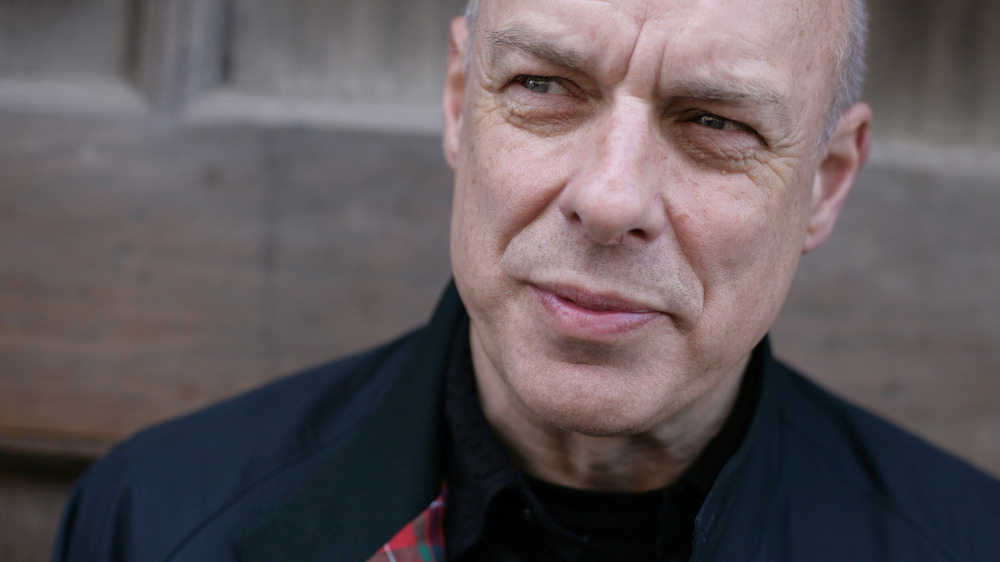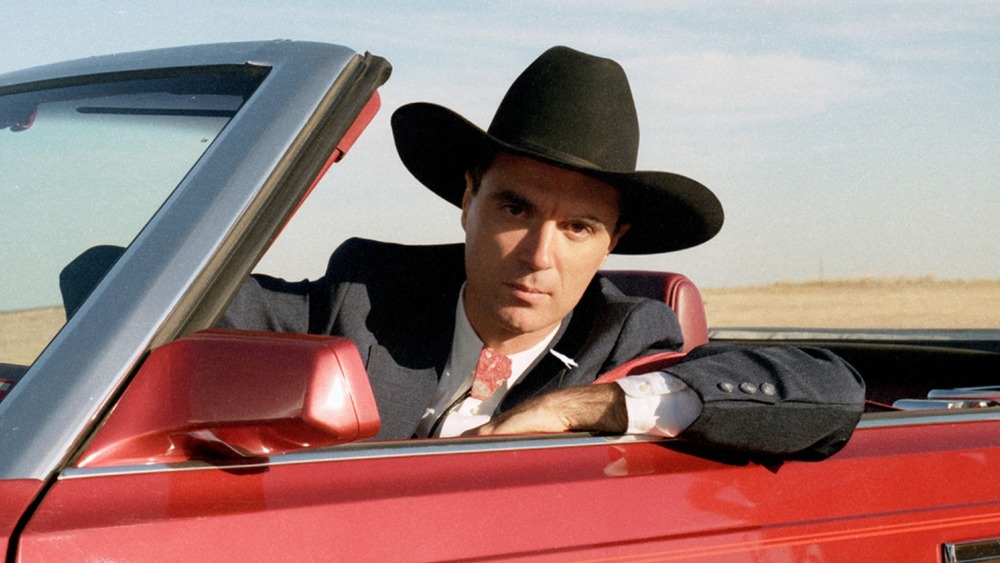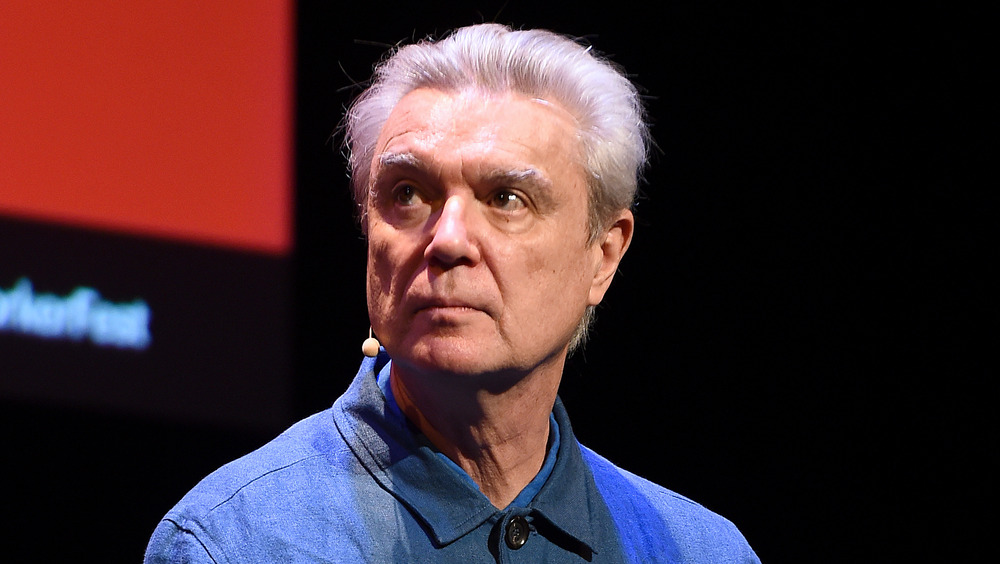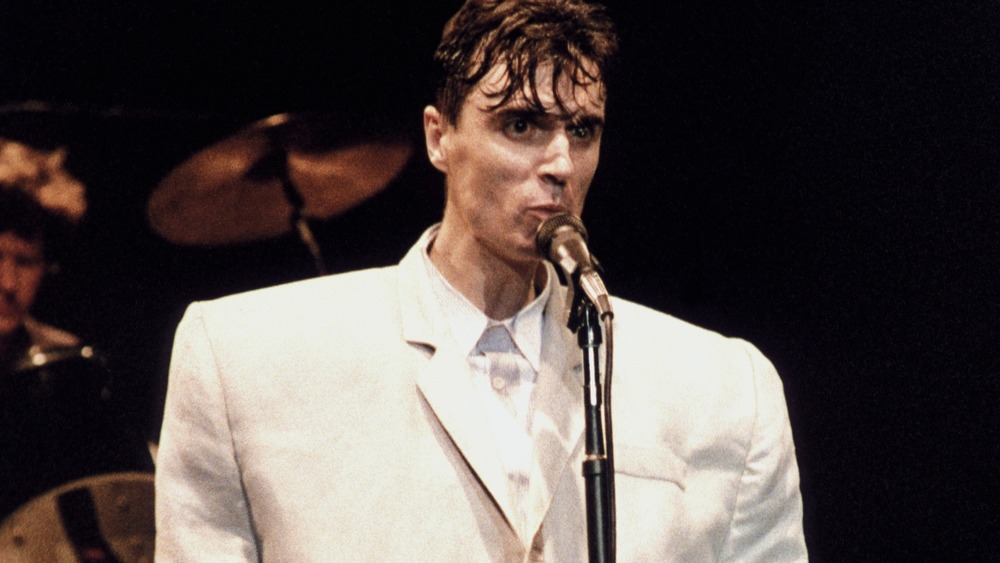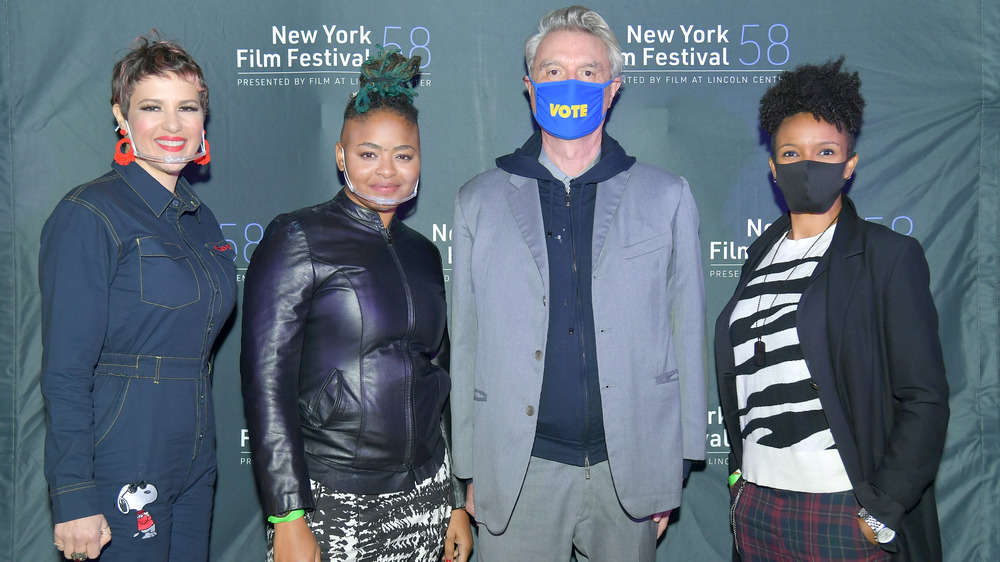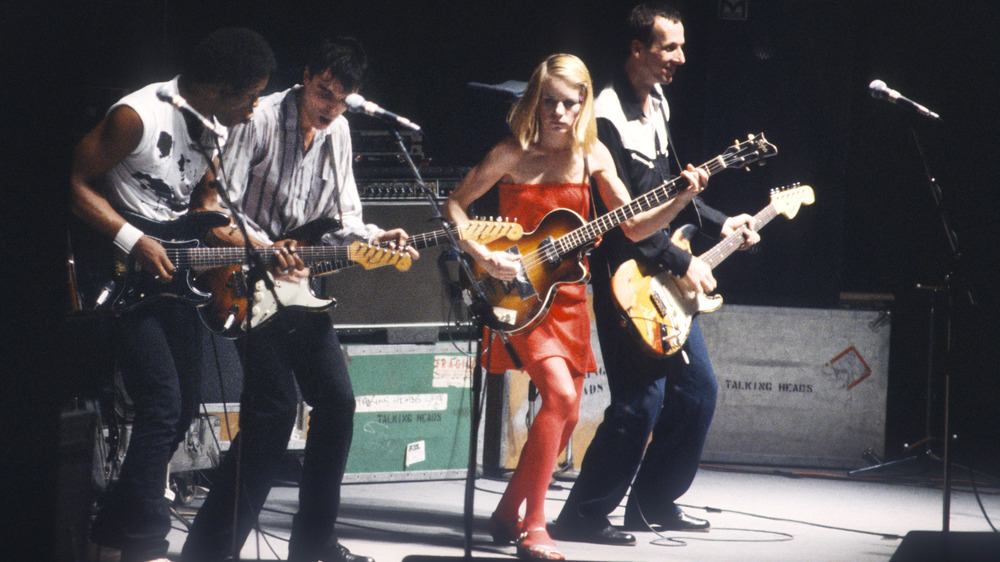The Untold Truth Of David Byrne
David Byrne is one of those artists that can be hard to define, but if one word had to be used, it would probably be "eccentric." From his cartoonish, oversized suits to his iconic, strange vocal tone and experimental composition, Byrne has dabbled in world music, podcasting, epistemology, Broadway, writing, and bicycle design. But what most people know him as is the leader of superstar '80s new wave band the Talking Heads.
Originally hailing from Scotland, Byrne emigrated to Maryland as a child and has been active as a musician since high school. He is a member of the Rock and Roll Hall of Fame and has won multiple Grammys, as well as an Academy Award for Best Original Score. Byrne has a plethora of knowledge in philosophy and the humanities and gets his inspiration from literally everywhere. In his TED Talk about how shape and space affect our creativity, he references West African music, Bach, and birds — all in less than 16 minutes.
Not only is he versatile and prolific, but he's still at it. Byrne's musical American Utopia is currently prepping for a comeback on Broadway this September. The show is Byrne's "secular church offering a tonic for our tumultuous times," according to Rolling Stone.
But who is the man behind the madness? Parts of his story may surprise you.
David Byrne's unique voice caused him problems early in life
As a kid, David Byrne was kicked out of the school choir because of his less than extraordinary pipes. His father flat-out stated to The Washington Post, "he couldn't sing." But that didn't put David off music. "He had a little record player when he was 3," Tom Byrne said. "It was a cheap little thing but he played it quite well, and he was always careful not to damage the records."
David used his dad's modified tape machine to make music at a very young age and learned a variety of instruments, such as violin and guitar. Tom recalled that he enjoyed messing with stretching frequencies and mixing tracks.
What does David think about the importance of vocal technique in music? He once said, "The better the singer's voice, the harder it is to believe what they're saying. So I turn my weakness into strengths."
David Byrne's early musical days
David Byrne knew how to play many instruments before entering high school, including the violin, accordion, and guitar. His interest was piqued at age three when he got his record player, and he started playing harmonica at age five, per Time Magazine. He came by music honestly, with his father working as an electronics engineer.
Byrne describes his childhood as "uneventful" in a Rolling Stone exposé. Growing up in the 1960s, he formed his first band, Revelation, which mostly performed covers. "I think we did a couple of Beatles songs, Rolling Stones songs, 'You Really Got Me,' stuff like that," Byrne said. After the band broke up, he headed to college, where he played the coffee house circuit solo. David not only loved music, but his dad instilled in him a love of science, and he had considered attending vocational school before landing on art school.
How did Byrne ultimately pick where to go to school? "The graffiti at RISD looked the best," he mused playfully. "It looked like it had the most interesting people there. So I thought, even if I don't like the subject, I don't want to hang around with a bunch of deadbeats for four years." It's fitting that this is where he met some of his fellow Talking Heads bandmates.
David Byrne was kicked out of art school
Before becoming a rock star as part of the Talking Heads, David Byrne attended an art school in Rhode Island, where he studied functional design. And it's at the Rhode Island School of Design that he fatefully met two of the future members of the Talking Heads.
At RISD, he was involved in a functional design program called the Bauhaus Theory course. Bauhaus is a method founded in Germany that replaces the traditional pupil-teacher relationship. Its aim was to bring art, architecture, performing arts, and design back into everyday life and to be taken as seriously as fine art. David's teachers weren't very impressed with his creative pursuits, according to a Talking Heads bio site. In one instance, David had his beard shaved off onstage accompanied by an accordion while a showgirl displayed cards written in Russian. He was soon kicked out of the school.
Luckily Byrne had already met Talking Heads band members Chris Frantz and Tina Weymouth. Chris and Tina, a couple who are married today, joined David in New York after graduating. "I think art school is a real racket [...] You run into a couple of good teachers and some interesting students, but for the amount of money you spend, it's not worth it," Byrne said.
David Byrne isn't just a musician
Not only did David Byrne attend art school for functional design, but he's also a nonfiction author and conceptual artist who has written books on everything from music to epistemological information. Many of his published works focus on vastly different subjects, such as Bicycle Diaries, which is a journal of his cycling ventures through cities around the world. He also apparently designs bike racks, according to Rolling Stone.
Byrne also recently produced a multimedia project called Reasons to Be Cheerful, which focuses on reasons to stay optimistic about the world, including gains in the solar industry and efforts to eliminate poverty.
Given Byrne's versatility, it's safe to assume that all of his exploits eventually lead to better music writing. "You can only slog away at writing a song for so long and then you've kind of gotten the water out of the well — and you need to let the well fill up again," he said to Rolling Stone. "I also compartmentalize a lot. I focus on one thing for a few hours and then break for lunch and work on something else."
David Byrne's reputation as a band member turned sour
Don't touch him, he's a real live wire.
Apparently, David Byrne wrote the song "Psycho Killer" somewhat from personal experience. The frontman's temper and dishonest dealings caused much consternation between him and fellow Talking Heads bandmates, particularly toward the end of their time together. Byrne would even bill himself as the sole creator of the band, which caused a rift between him and drummer Chris Frantz. Chris wrote a memoir, Remain in Love, about his experience in the band. "The more successful Talking Heads became," Frantz wrote, "the more cold and dyspeptic David became." Byrne's actions came down to being self-centered. Frantz, who he'd known since his early art school days, told The Guardian, "It's like he can't help himself. His brain is wired in such a way that he doesn't know where he ends and other people begin."
These days, Byrne has mellowed out and come to certain realizations. "I think I probably did not behave all that well all the time. [...] It was a very messy thing," he recalled to The Guardian in 2018. "I can imagine I must at times have been a real pain in the ass to deal with."
While the band sadly never fully resolved their issues, at least Byrne has owned up to his misbehavior.
David Byrne and Brian Eno's music partnership
Brian Eno and David Byrne met at London's Rock Garden while accompanying friend and fellow musician John Cale of the Velvet Underground in May 1977. The Talking Heads were opening for the Ramones that day. According to Diffuser, Eno invited Byrne back to his apartment to listen to music after the concert.
Eno went on to produce three of the Talking Heads' albums and three of Byrne's solo projects. His contribution paid off for the band. Their first collaboration resulted in the band's first Top 40 hit, which was a cover of Al Green's "Take Me to the River." Byrne and Eno ran into some heat, however, when they tried to claim sole writing credits on what is widely known as the Talking Heads' masterpiece album, Remain In Light.
"Eno's haphazard instinct helped turn the brittle and wary Talking Heads into a supple, playful, Dada-esque dance band," wrote Sasha Frere-Jones of The New Yorker (via Diffuser). Eno and Byrne reunited 27 years after their last collaboration to work together again for the album Everything that Happens will Happen Today in 2008. "Eno gave me confidence in the studio," Byrne said, "to go in with nothing prepared."
David Byrne's film work
Considering his prolific and varied artistic pursuits, it comes as no surprise that David Byrne has tried his hand at movie-making.
In 1986, Byrne made a feature-length film called True Stories, starring John Goodman and Swoosie Kurtz, about America in the '80s, and it's just as weird as he is. The film is set in Virgil, Texas, and focuses on a handful of characters that have all been the subject of tabloid news headlines.
How did Byrne feel about the film's outcome and audience reception? "The reaction and appreciation in Europe was closer to what I intended the film to be," Byrne told Rolling Stone in an interview. "You could point out things that are strange and wacky, but you can still love them. In the U.S., it was taken to be ironic and critical, a New Yorker looking down his nose at the simple wacky people in the heartland, which is not what I intended."
True Stories became part of the prestigious Criterion Collection in 2018. The movie would be Byrne's last time behind the camera for a feature, but it wasn't his only contribution to film. He has also collaborated musically with directors like Jonathan Demme, who directed the Talking Heads' concert film Stop Making Sense. He also worked with Spike Lee in creating the concert film for American Utopia.
David Byrne's music collabs
David Byrne is a prolific solo musician and has made records with younger musicians like St. Vincent and Arcade Fire. Byrne was a backup singer for the Arcade Fire track "Speaking in Tongues," as part of the deluxe version of their 2010 album The Suburbs. In 2012, he and Annie Clark, aka St. Vincent, released the album Love This Giant.
Byrne also performs a Janelle Monae song, "Hell You Talmbout," which is an anthem about police brutality against the Black community, in his musical American Utopia. Monae never officially released the song, but Byrne learned of it by watching a video of her performing it in 2015. "Here was a protest song that doesn't hector or preach at us," Byrne said according to Billboard. "It simply asks us to remember and acknowledge these lives that have been lost."
Monae was flattered when Byrne approached her for permission to perform the song. "I was moved that he reached out and asked if he could include the song in his show," she told the Associated Press (via Billboard). "The song's message and names mentioned need to be heard by every audience."
David Byrne made up a weird story about being drafted
One of the more bizarre stories about David Byrne involves a topic of strange fiction.
Byrne wrote an ode to anti-war activist and radical priest Daniel Berrigan, who died at the age of 94. Berrigan and the "Catonsville Nine" were known for burning 300 Vietnam draft records in Catonsville, Maryland, in May 1968. In his article remembering Berrigan, Byrne claims his name was one of the draft records, but he was later corrected.
"My records were among those burned. Were it not for Father Berrigan, the odds were very good my life would have taken a different path," Byrne wrote in The Guardian. "The actions of those soon dubbed the Catonsville Nine gave me a reprieve until the draft lottery was instituted a number of years later, and my number was sufficiently high that I knew they would never get that far."
Byrne was called out on the timeline later, after journalist Shawn F. Peters did some basic investigative work. Byrne had only been 16 when the draft records were burned by Berrigan, which would have made him two years too young to be sent to the Vietnam War. According to History News Network, Byrne admitted that his "autobiographical memory may in fact not be accurate" when questioned.
What's with the big suits?
David Byrne's signature stage costume has always been the overtly huge suits he used to wear when performing with the Talking Heads. But don't expect much of an explanation as to why. He did address it briefly in a bizarre interview with various versions of himself, channeling Eddie Murphy. "I like symmetry and geometric shapes," Byrne says in the comical video interview. "I wanted my head to appear smaller, and the easiest way to do that was to make my body bigger, because music is very physical, and often the body understands it before the head." Turns out his answer is just as strange as his getup.
The suit's designer, Gail Blacker, described it as "more of an architectural project than a clothing project," according to Put This On. Byrne's oversized costume was part of promoting the Talking Heads' 1983 tour and 1984's Stop Making Sense – which kind of makes sense.
The story behind American Utopia
Broadway's latest wacky and political musical is the brainchild of David Byrne. American Utopia originally opened for a limited run in October 2019, to positive reviews. The cabaret-style show, which is based on Byrne's studio album of the same name from 2018, is comprised of a small cast of 12 musicians performing a dozen or so songs amid a minimal set. According to NME, the show "blurs the lines between gig and theatre, poetry and dance; a full spectrum of culture under one roof."
As reported by The New York Times, the musical was adapted to film by Spike Lee and features Talking Heads hits like "Once in a Lifetime," as well as the single "Everybody's Coming to My House." Not only does Byrne perform one of Janelle Monae's songs, but the track "Toe Jam" was co-written by Fatboy Slim and Dizzee Rascal.
The musical is set to make a comeback to the stage in September 2021.
Will Talking Heads ever reunite?
Talking Heads was a groundbreaking rock band that blurred genre lines, composing sounds from post punk to dance to world music. The foursome consisted of David Byrne, Chris Frantz, Tina Weymouth, and Jerry Harrison. They were active from 1975 to 1991 and are considered emblematic of America in the '80s. They landed a spot in the highly coveted Rock and Roll Hall of Fame in 2002, and four of their albums have made Rolling Stone's list of the 500 Greatest Albums of All Time. It's safe to say that many fans, young and old, would love to see the band reunite. But will it ever happen?
David Byrne says no, and he has his reasons, one being that he's not interested in music for nostalgia's sake. According to Rolling Stone, he has stated that he's "avoided a Talking Heads reunion because it would overshadow the other things" he's done. "With someone like the Pixies, it's different," Byrne says regarding band reunions. "They're getting the audience now that they deserved ages ago. But with a lot of them, it just seems like you don't have anything new to say, and you go, 'OK, this is just some kind of nostalgia exercise.' And I'm not interested in that."
